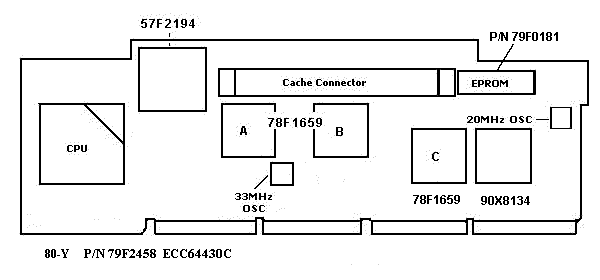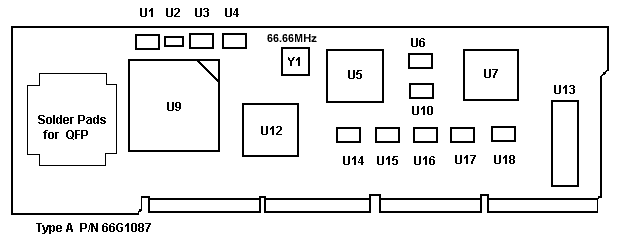Pictures for Processor complexes
stored in this page are originally created by
Louis Frederick Ohland.
You can see original pictures for PS/2 complexes
at Louis's
complex page.
General information
Model 5580 is almost same with PS/2 model 9595 which uses 1 serial
1 parallel planar.
Basically there are 2 variations of this model.
One is -Yxx model which uses PS/2 type-K -ish complex and the
other is -Wxx model which uses PS/2
type H/L -ish complex. ( both have different BIOS P/N from
whose used on PS/2 complexes )
As a matter of fact 580 doesn't support Syncro Streaming Data Transfer
mode.
Entry server models, they were.
Planar
Uses 1S1P planar. I don't see any distinctive
difference from Mod. 95 1S1P planar ( except BIOS EPROM ).
Click here
for 1S1P planar outlined by Louis.
80-Yxx Processor
complex P/N 79F2458 
Base clock is 33MHz and a 486DX-33 is loaded on the socket.
A daughter board for 256K cache is available as an option (
P/N 79F1294 ECC 63993A ).
Memory count is.... very slow like 5560-W0x complex.

* Original image was
outlined by Louis F. Ohland *
As you can see, 80-Y complex doesn't have overdrive socket.
The complex does not have solder pads just like as Type-1 DX
2-66 upgrade, but 80-y complex uses EPROM for BIOS while PS/2
type-1 DX2-66 upgrade ( 92F0145 ) uses EEPROM ( Flash ROM ).
The Board P/N is different from 61-W0 complex but all the parts and
chips used are same except OSCs. Same BIOS ( P/N 79F0981
) is commonly used for 80-Y and 61-W0 .
CPU upgrade
Easy to use DX2-66. You can also use DX4-100, am5x86-133 and
Cyrix5x86-100 together with
an interposer. |
80 -W0x/W2x
P/N 07G3153
Processor complex is completely same with the one used for 5560-W1/W2
model.
Requires REF/DIAG specified for 5580-W ( those for 5560-W1/W2 could
not be used fro 5580- W/W2 ).
Complex information
P/N 07G3153
REA 19602276
BIOS 07G0463 ( IBM 1981- 1991 )
Silk print on lower left corner shows " IBM FRU
95F4299", "ANOIBM486SXB25".
CPU
5580-W0x i486SX25 sits on socket position
U8 of 80-W0 complex.
5580-W2x Earlier models shipped with
i486SX25 + ODPDX2-50 ( ID#06G7015 ) on the socket U9.
Later models shipped with i486DX2-50 alone on the socket U9.
2002.12.22
I got a following message while I was creating reference
diskette for this model.
Seems "Canberra" is the code name for 5580-W .
Does "P23T" mean DX4ODP ?
DX2-66 Up grade Type-A
P/N 66G1987 
Memory count is extremely fast.
Supports Syncro Streaming data transfer feature and 2.88MB floppy.

* Original type2-H GIF image was outlined by Louis F. Ohland *
U1
74F32
U2 74F125D
U3 74F00
U4 74F04
U6 74F760D
U10,U14-U18 74F244 |
Y1
66.666MHz
U5/PA2
59G1883
U7/DMA32 10G7808
U9/PGA
DX2-66
U12/PF2
59G1885
U13/BIOS
P/N 66G1095 |
SCSI limitation
5580-Y/W models use older type of long
SCSI /A with cache ( SPOCK 6451018 ).
Even though a newest SPOCK is used
, 5580 can't handle a hard drive larger than 1G as an IML drive.
In order to get full potentiality of newest SPOCK,
8595-J type-3 complex or any other type-4 complex should be used together.
Can 5580 take pure PS/2 complexes ?
The answer is "Yes", using correct reference and diag disks
for the PS/2 platform you want to use. Some of my friends succeeded
to configure a Type3 DX50 complex and Type4-N/Y complex on 5580.
No reports regarding PS/2 Type 1 or Type 2.
Comparing
chart for processor complex.
Following chart is originally explained by Mr. NATICA ( pseudonym ),
one of true MCA enthusiasts in Japan who helped me in many ways to
play with my PS/55s.
|
PS/2
|
CPU
|
PS/55
|
P/N for PS/55
|
O/D socket
|
Remarks
|
| Type 1-G |
486SX20/25 |
-------- |
----- |
------ |
|
| Type 1-J |
486DX25 |
5561-W0x |
79F0087 |
None |
|
| Type 1-K |
486DX33 |
5580-Yxx |
79F2458 |
None |
|
| Type 1 U/G |
486DX50 |
------- |
------ |
----- |
|
| Type 1 U/G |
486DX2-66 |
------- |
------ |
----- |
|
| |
|
|
|
|
|
| Type 2-H |
486SX25 |
5561-W1 |
07G3153 |
Yes |
|
| Type 2-H |
486SX25 |
5580-W0x |
07G3153 |
Yes |
|
| Type 2-H |
486DX2-50 |
5561-W2x |
07G3153 |
DX2 loaded |
|
| Type 2-H |
486DX2-50 |
5580-W2 |
07G3153 |
DX2 loaded |
|
| Type 2-L |
486DX2-50 |
------- |
------ |
----- |
|
| -------- |
486DX2-66 |
Opt for 5580 |
66G1087 |
Solder Pads |
*1, *3 |
| -------- |
486DX2-66 |
5560-N |
35G2951 |
Solder Pads |
*2, *3 |
| Type 3 and all of Type 4 Complexes are commonly used for PS/55 8595-J
and Mod. 95.
I guess PS/55 66G1087/32G2951 are both Japanese unique complexes. No
equivalents in PS/2
can be observed in Louis's page or in MCA Adapter Picture page maintained
by Dennis and Peter.
Remarks
*1 This complex is called as "DX2-66
Up Grade Type A".
*2 This complex is called as "DX2-66
Up Grade Type B". Originally equipped in 60-Nxx.
*3 Base clock is 33MHz but is apparently different from
"DX2-66 upgrade 92F0145".
Both Type A and B use big
DIP type EPROM.
Type-A can be used both in 5560 and 5580 while Type B can only
be used in 5561. |
Some tips
for 5580/5560
1. Ref Ver. 1.21 is what you should have.
If you have more than 16MB of RAM in
total, you need a reference diskette Ver.1.21 to let the system recognize
whole RAM installed.
( Ver. 1.11 for 5561 )
2. Under Win95 the system report only 16MB of RAM though you have
more than 16MB of RAM.
Replace HIMEM.SYS of Win95 to
the one in PCDOS J7.0 then Win9x will see actual RAM you installed.
This symptom
is commonly observed on the other 486 IML machines but not on EIDE machines such as 5551-R/L
and
5530-L.
3. F/W SCSI-2/A can't be used alone in 5580 with original complex.
Not sure about this issue.
It is told that PS/55 BIOS doesn't contain SCSI code (maybe).
I haven't yet tested but it is told that
;
If you want to use F/W SCSI-2/A on 5580,
you need to use an usual SPOCK SCSI /A together with F/W SCSI-2/A.
Server
models other than 5580.
9585, 8595-J with type- 3 M platform
and 9595 N/P/Q are same with corresponding PS/2s.
All models were originally equipped with Japanese ref/diags,
but they can accept English Ref/Diags too.
Japanese models of 9595 are all 2S2P type with Type 4 platform.
No differences can be observed except model-type code and PS/55
badge.
I have nothing to say about these machines.
You can find a lot of info at Ardent
Tools of Capitalism ( mirror page) created by Louis Ohland.
The earlier version is available here.
Clock Rodding
for PS/55s.
Clock rodding is, err.., evil way especially for PS/2
and PS/55. What we expect for these machine are stable
operation and reliability. So it is not recommended to change OSC
for 20 - 28MHz inner speed.
International Business Machines do not expect clock modification.
I was just a MAD. It's better to keep your MCA box *clean*.
But anyway here we go.....
Japanese Type-1 J with 25MHz OSC for 61-W0 can take 30MHz
OSC without any trouble. But all other complexes couldn't take any higher
OSC in stead of originally equipped OSCs ( actually speaking,
one can use 35MHz OSC in stead of 33MHZ for some complexes
). In most cases, you need to modify BIOS for changing
base clock of PS/55. Without BIOS modification, system will
hung up during POST with 102 error code.
I didn't ( well actually "I still don't " ) have
any knowledge to read or write BIOS. Mr. Sugiura, one
of my friends who knows about reading /writing BIOS, examined BIOS
of 5561-W1x complex and he MODIFIED the BIOS
so that 61-W could boot without 102 error.
According to him, there are several lines indicating to jump up to
102 error section during POST routine. He couldn't determine the
line which exactly related with changing of the system clock. Then
he rewrote all concerning lines not jumping to 102 error section.
I don't know if his modification includes some bugs or not. But, so far,
BIOS ROM with his modification works fine at least in my systems.
He kindly examined another models' BIOS ROM and burnt new EPROMs
for me and for other members of the forum.
List of models and complexes modified by Mr. Sugiura.
| Model |
Original OSC |
Replaced to |
Up Rated from/to
|
Type of BIOS ROM
|
| 5551-N |
66.66MHz |
84MHz
|
33 to 42MHz
|
PROM, write one time
|
| 5551-W0 |
40.00MHz |
60MHz
|
20 to 30MHz
|
PROM, write one time
|
| 5561-W1/W2 |
50.00MHz |
62MHz
|
25 to 32MHz
|
EPROM
|
| 5580-Y |
33.33MHz |
40MHz
|
33 to 40MHz
|
EPROM
|
| Type-A upgrade |
66.66MHz |
80MHz
|
33 to 40MHz
|
EPROM
|
| Type-B upgrade |
66.66MHz |
80MHz
|
33 to 40MHz
|
EPROM
|
modification story is available in this
page too.
Line #3 amended from 5551-W1/W2 to 5561-W1/W2 on
10.11.2002
PS/55 Index
|


